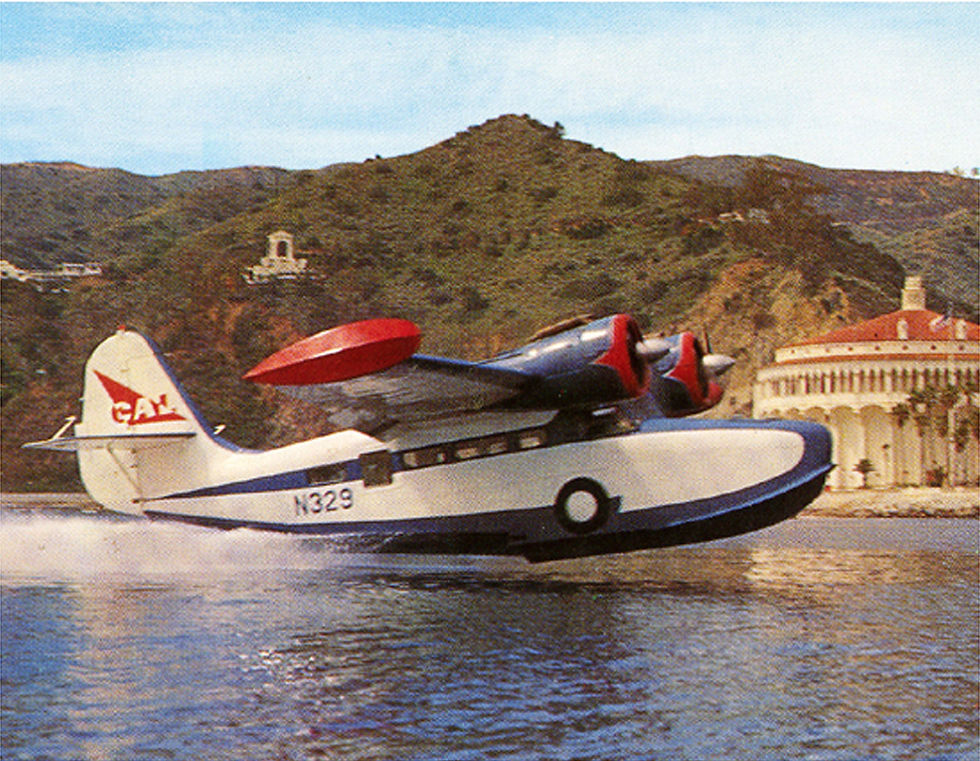The Ghost in the Grumman Goose
- Jim Watson
- Aug 29
- 3 min read
Updated: Sep 7

To paraphrase the Bard, there are more mysteries on Catalina Island, Horatio, than are dreamt of in your philosophy. The bizarre, at times, is the commonplace upon these shores and for this post it’s time for a ghost story of sorts.
Robert Hanley made a local name for himself during the post-war years as a pilot for Amphibian Air Transport and later Avalon Air Transport. In the late 1950s, he was the owner and operator of Catalina Channel Airlines, an enterprise that lasted nearly a decade.
In a book titled Ghosts of the Air: True Stories of Aerial Hauntings written by Martin Caidin, Hanley writes a guest piece about a nerve-wracking, and ultimately mysterious event that took place in the late 1940s when Hanley was flying for Amphibian Air Transport.
It was on a cool autumn day when Hanley and ten passengers slowly climbed in a Grumman Goose G-21 from the airport in Burbank bound for Catalina through the low cloud cover surrounding the nearby Hollywood Hills.
It was the last flight of the day, but trouble started early when Hanley emerged from the clouds only to notice cars on the highway above his plane along a nearby ridge, possibly in the Malibu Hills. Just climb higher real soon, he told himself. And so he did.
But the new altitude brought its own problems in the form of ice, which rapidly began coating the plane’s radio antenna. The ice didn’t stop there, however, and soon his entire windshield was covered with it, making it impossible to see anything ahead of the plane.
The tension was eased considerably after Hanley finally got the Goose above the cloud cover. But although he now had good visibility out the side windows, he realized that the cloud cover obscured all of the ground below. “That cloud cover, now below us was absolutely flat as far as the eye could see. Not a lump anywhere,” he wrote, referring to the idea that a lump in the clouds would indicate the presence of the island beneath them.
Then, things got a whole lot worse when the ice building up on the antenna suddenly broke away, taking the whole antenna with it. Hanley and his passengers were now several thousand feet in the air with cloud cover between them and terra firma and no way of communicating with those on the other side of those clouds.
No problem, thought Hanley to himself. “Fly your airplane, dude,” he told himself.
Using an old pre-radar pilot trick, he counted the minutes, knowing that it was 20 minutes from Burbank to Long Beach and another 17 minutes from there to Catalina.
After 30 minutes, he began easing the plane lower, bit by bit, calculating that by now he was over the open water, approaching the Island on the leeward side. They descended lower and lower until they were swallowed up by the clouds. Would the Goose and its occupants find open sea below them? Or would they plow directly into East Peak or Mt. Orizaba?
He was now well on his descent on a heading of 180 degrees when a “voice” clearly spoke to him over the headphones, he writes. “Turn to nine zero degrees,” said the voice. “TURN NOW!”
It took Hanley a moment to realize that he still had his headphones on; headphones that —because of the missing radio antenna—should have been completely and utterly useless.
Hanley obeyed the mysterious voice and rolled his Goose 90 degrees. Immediately, the plane broke through the clouds at 900 feet right into the middle of mountainous terrain. “Hills and mountains loomed all about,” he wrote, “under and to the right of my wingtip.”
Within minutes, as Hanley tried to figure out just exactly where he was (had he circled around somehow and was back over the mainland?) he looked directly below the nose of the airplane and saw Avalon. After a nail-biting half hour, Hanley safely landed his plane and its passengers.
Hanley would later discover that the “absolutely flat” cloud cover was flat only because of a 70-mile-an-hour wind, which had pushed his plane much further along than he had reckoned. These winds, he calculated, would have almost guaranteed that—without making the turn—he and his hapless passengers would have plowed straight into Mt. Orizaba.
“I didn’t hit the mountain because a voice in dead earphones, when I was flying absolutely blind, told me to ‘turn to nine zero degrees. TURN NOW!”
“Where did that voice come from?,” he asked himself. “That’s where I run out of answers. The whole thing seemed impossible, but I’d heard the voice, and I obeyed it.”
Robert Hanley has long since passed from this earthly plane and from his earthly planes. But without the “Ghost in the Grumman Goose” that passing could have occurred much earlier.



Comments